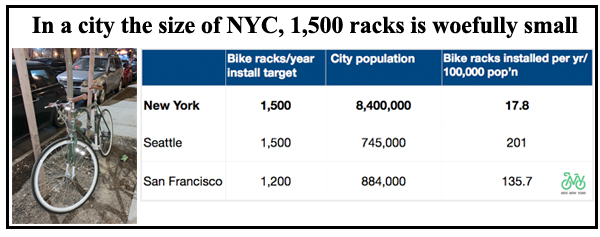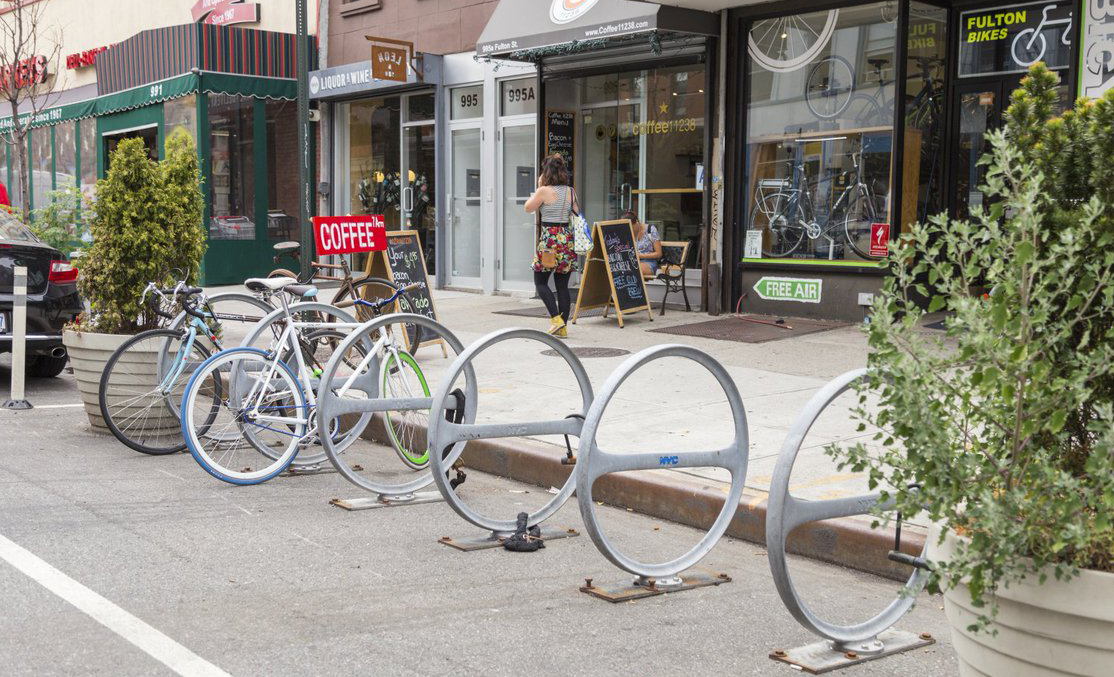After a lackluster year in which the city carved a mere four bike parking areas out of curbside spaces, the Department of Transportation is renewing its once-bustling Bike Corral program.
The program — through which businesses and citizens can apply for the city to design and install bike racks in the street instead of on the sidewalks — is soliciting new applications this summer, its website confirms.
“The corrals are a great program,” said Janet Liff, the director of the Neighborhood Empowerment Project, which has been watching the program (and its failures) for quite some time. “Not only do they give cyclists an actual place to park, but they also attract customers to businesses and provide parking for delivery cyclists, all of which leads to a more orderly streetscape that benefits everyone."
The bike corrals — round racks placed in a painted zone along the curb, sometimes with extra goodies like planters or seating — are “a great solution for places where demand for bicycle parking exceeds the available sidewalk space,” according to the DOT’s website, which notes that “anyone can request a Bike Corral, but every corral needs a maintenance partner to keep the Bike Corral clear of snow and debris.”
Applicants and maintenance partners may be "businesses, community groups, and/or individual volunteers,” per the site. Once a corral is installed, the agency spot-checks it to make sure that it is being kept free of litter and snow — and will remove it if conditions warrant.
A DOT spokesman said that the number of applications and eligible locations vary from year to year, and that the department is working to incorporate bike corral-style parking into other programs and initiatives, including the Street Seat Program. He said there are already 10 applications for this season.
The Bloomberg administration started the Bike Corral program after a survey showed that cyclists ranked “No safe storage facility” as a main reason New Yorkers were not riding to work. The DOT responded with two programs: CityRacks — which maintains more than 28,000 bike racks on sidewalks in order to discourage people locking their rides to signs, mailboxes, or other street structures — and Bike Corrals.
Building out the Bike Corrals has been a slow process, however. The program started auspiciously enough, ramping up from one corral in 2011 to 21 in 2013. But the pace slowed; now there are just 67 on-street bike corrals citywide (none in Staten Island and only two in the Bronx). By comparison, Portland, Ore. — a city of a mere 648,00 people — has 158.
“New Yorkers on bikes need many more bike racks, whether in corrals or on the curbside,” said Jon Orcutt, head of advocacy for Bike New York. “But for reasons known only to itself, the de Blasio administration has scaled bike-rack installation down dramatically. It’s a very weird disconnect for a team that prides itself on expanding protected bike lanes.”
Orcutt’s group is publicizing the statistic (see chart below) that the city has been installing only 17.8 bike racks per year per 100,000 population, while Seattle installs 201 annually for that number of people and San Francisco 135.

The main problem? Car drivers are so insistent that all curbside space belongs to them — and the DOT enables that belief by bringing any changes to even a single parking space to the local community board.
Once a community board is involved, the process can drag on for months and years. The West 50s Neighborhood Association, to cite one especially Kafka-esque case, has been trying to get a corral for six years.
For some reason, removing a "parking" space — whether for bike parking or for a Citi Bike rack — is endlessly bureaucratic — an irony, advocates say.
“The city allows people from anywhere in the country to park their Chevy Suburbans or any other private car on our streets for free, no questions asked,” said Brooklyn activist Doug Gordon, who spent a year getting a bike corral installed next to PS 118 in Park Slope. "Obviously, the corral process must be reformed.
https://twitter.com/mikecherepko/status/1228362853956059136?s=12
“People shouldn't be required to have inside knowledge of how city government works or become part-time advocates to get such a basic amenity,” Gordon continued. “Given the triple threat of congestion, traffic violence and climate change, the time between requesting a bike corral and installation should be measured in weeks or months, not years. Any business, property owner, or civic organization that wants on-street bike parking should get it, no community-board approval required.”
The tardiness on removing car parking in favor of infrastructure for sustainable modes of transportation comes as the city is also prioritizing car parking over Citi Bike docking stations in its latest expansion plan, Streetsblog reported this week.
The bottom line, added Liff, is that if the city truly wants to encourage cycling and discourage driving, it needs to make the former easier and the latter harder.
“Back when the city began encouraging cycling, it promised to provide more bike parking to meet the demand,” she said. “Now the typical cyclist is happy to find scaffolding or a free bus pole to lock up to. Neither of these options is ideal as we already have limited sidewalk width and the bikes wind up imposing on that space.”
To apply this summer for a bike corral to be installed for 2021, visit the DOT website here.






